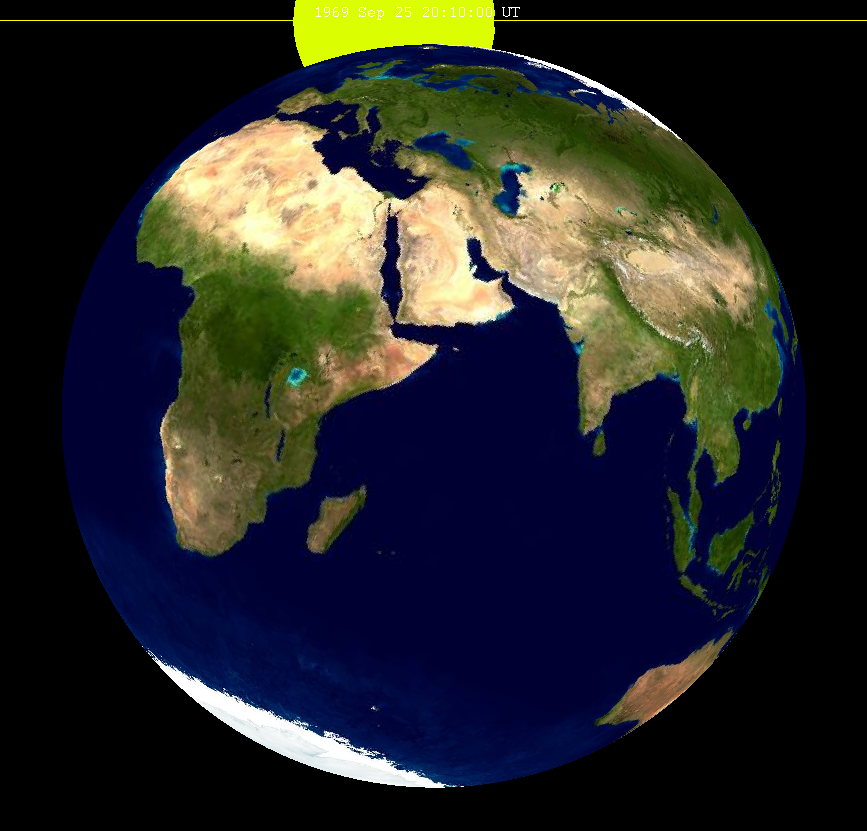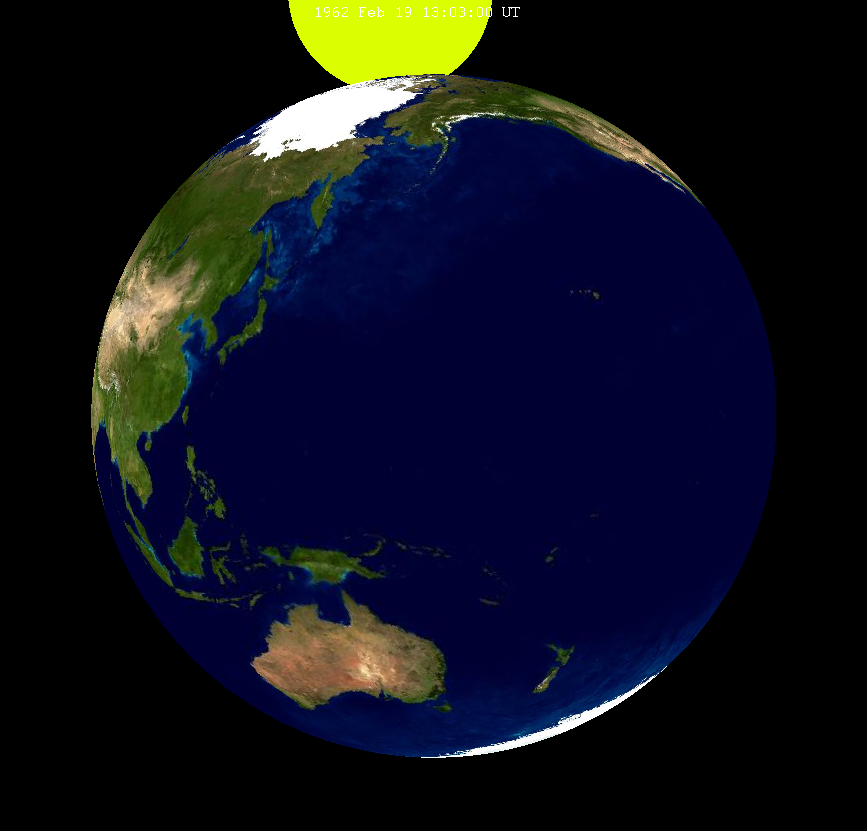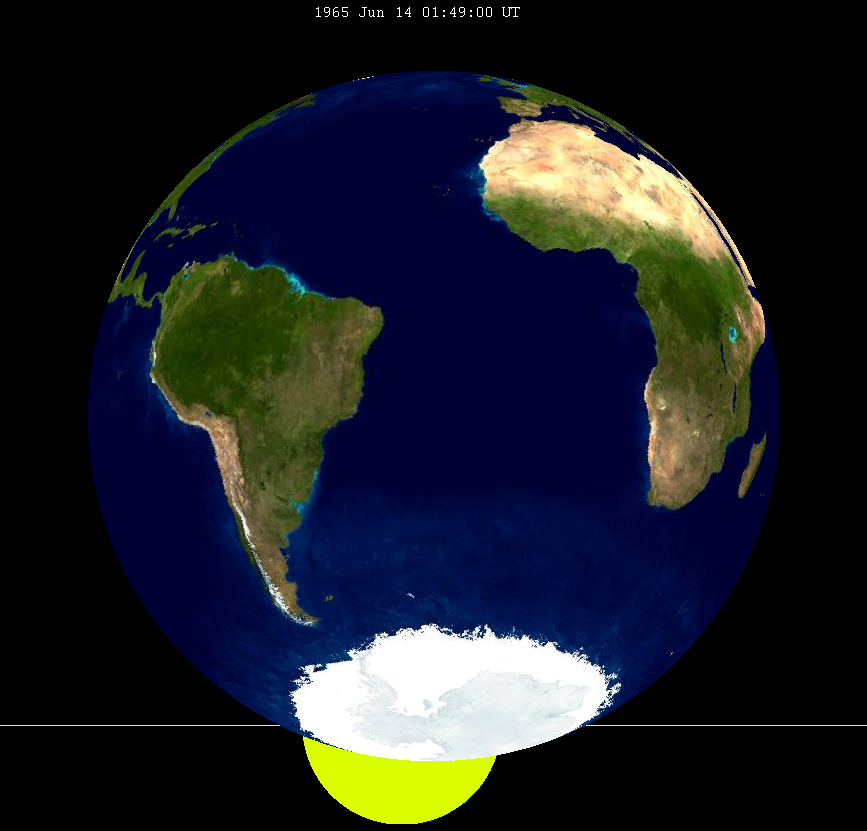|
December 1965 Lunar Eclipse
A penumbral lunar eclipse occurred at the Moon’s Lunar node, ascending node of orbit on Wednesday, December 8, 1965, with an umbral Magnitude of eclipse, magnitude of −0.1200. A lunar eclipse occurs when the Moon moves into the Earth's shadow, causing the Moon to be darkened. A penumbral lunar eclipse occurs when part or all of the Moon's near side passes into the Earth's penumbra. Unlike a solar eclipse, which can only be viewed from a relatively small area of the world, a lunar eclipse may be viewed from anywhere on the night side of Earth. Occurring about 2.5 days before Apsis, perigee (on December 11, 1965, at 6:00 UTC), the Moon's apparent diameter was larger. Visibility The eclipse was completely visible over eastern Europe, northeast Africa, Asia, and Australia, seen rising over western Europe and much of Africa and setting over northwestern North America and the central Pacific Ocean. Eclipse details Shown below is a table displaying details about this particular ... [...More Info...] [...Related Items...] OR: [Wikipedia] [Google] [Baidu] |
Lunar Eclipse
A lunar eclipse is an astronomical event that occurs when the Moon moves into the Earth's shadow, causing the Moon to be darkened. Such an alignment occurs during an eclipse season, approximately every six months, during the full moon phase, when the Moon's orbital plane is closest to Ecliptic, the plane of the Earth's orbit. This can occur only when the Sun, Earth, and Moon are exactly or very closely aligned (in syzygy (astronomy), syzygy) with Earth between the other two, which can happen only on the night of a full moon when the Moon is near either lunar node. The type and length of a lunar eclipse depend on the Moon's proximity to the lunar node. When the Moon is totally eclipsed by the Earth (a "deep eclipse"), "What is a deep eclipse? The smaller star is behind the bigger star" it takes on a reddish color that is caused by the planet when it completely blocks direct sunlight from reaching the Moon's surface, as the only light that is diffuse reflection, reflected from ... [...More Info...] [...Related Items...] OR: [Wikipedia] [Google] [Baidu] |
Lunar Eclipse Chart Close-1965Dec08
Lunar most commonly means "of or relating to the Moon". Lunar may also refer to: Arts and entertainment * ''Lunar'' (series), a series of video games * "Lunar" (song), by David Guetta * "Lunar", a song by Priestess from the 2009 album ''Prior to the Fire'' * Lunar Drive-in Theatre, in Dandenong, Victoria, Australia * Lunars, a fictional race in the series ''The Lunar Chronicles'' by Marissa Meyer Other uses * Lunar dynasty, a legendary house of warrior–rulers in ancient Indian texts * Lunar Magic, Super Mario World level editor * Lunar Design, or LUNAR, a San Francisco-based design consultancy * Hasselblad Lunar, a digital camera * Lunar, a brandname of Ethinylestradiol/cyproterone acetate, a birth control pill * Lunar C (Jake Brook, born 1990), English rapper * LUNAR (software) (1970–1972), question-answering system by Bill Woods (computer scientist) See also * * * Lunar calendar, based upon the monthly cycles of the Moon's phase ** Lunar day, in such calendars ** Lunar ... [...More Info...] [...Related Items...] OR: [Wikipedia] [Google] [Baidu] |
Solar Eclipse Of December 2, 1956
A partial solar eclipse occurred at the Moon's ascending node of orbit on Sunday, December 2, 1956, with a magnitude of 0.8047. A solar eclipse occurs when the Moon passes between Earth and the Sun, thereby totally or partly obscuring the image of the Sun for a viewer on Earth. A partial solar eclipse occurs in the polar regions of the Earth when the center of the Moon's shadow misses the Earth. A partial eclipse was visible for parts of Europe, Northeast Africa, and Asia. Eclipse details Shown below are two tables displaying details about this particular solar eclipse. The first table outlines times at which the moon's penumbra or umbra attains the specific parameter, and the second table describes various other parameters pertaining to this eclipse. Eclipse season This eclipse is part of an eclipse season, a period, roughly every six months, when eclipses occur. Only two (or occasionally three) eclipse seasons occur each year, and each season lasts about 35 days and ... [...More Info...] [...Related Items...] OR: [Wikipedia] [Google] [Baidu] |
January 1973 Lunar Eclipse
A penumbral lunar eclipse occurred at the Moon’s descending node of orbit on Thursday, January 18, 1973, with an umbral magnitude of −0.1292. A lunar eclipse occurs when the Moon moves into the Earth's shadow, causing the Moon to be darkened. A penumbral lunar eclipse occurs when part or all of the Moon's near side passes into the Earth's penumbra. Unlike a solar eclipse, which can only be viewed from a relatively small area of the world, a lunar eclipse may be viewed from anywhere on the night side of Earth. Occurring about 2 days after perigee (on January 16, 1973, at 20:50 UTC), the Moon's apparent diameter was larger. This eclipse was the first of four lunar eclipses in 1973, with the others occurring on June 15 (penumbral), July 15 (penumbral), and December 10 (partial). Visibility The eclipse was completely visible over Europe, Africa, and Asia, seen rising over eastern North America and much of South America and setting over east Asia and Australia. Eclipse detail ... [...More Info...] [...Related Items...] OR: [Wikipedia] [Google] [Baidu] |
October 1958 Lunar Eclipse
A penumbral lunar eclipse occurred at the Moon’s Lunar node, descending node of orbit on Monday, October 27, 1958, with an umbral Magnitude of eclipse, magnitude of −0.3118. A lunar eclipse occurs when the Moon moves into the Earth's shadow, causing the Moon to be darkened. A penumbral lunar eclipse occurs when part or all of the Moon's near side passes into the Earth's penumbra. Unlike a solar eclipse, which can only be viewed from a relatively small area of the world, a lunar eclipse may be viewed from anywhere on the night side of Earth. Occurring only about 15 hours after Apsis, apogee (on October 27, 1958, at 0:20 UTC), the Moon's apparent diameter was smaller. Visibility The eclipse was completely visible over Asia and Australia, seen rising over much of Africa, Europe, and the Middle East and setting over western North America and the central Pacific Ocean. Eclipse details Shown below is a table displaying details about this particular solar eclipse. It describes ... [...More Info...] [...Related Items...] OR: [Wikipedia] [Google] [Baidu] |
September 1969 Lunar Eclipse
A penumbral lunar eclipse occurred at the Moon’s Lunar node, ascending node of orbit on Thursday, September 25, 1969, with an umbral Magnitude of eclipse, magnitude of −0.0952. A lunar eclipse occurs when the Moon moves into the Earth's shadow, causing the Moon to be darkened. A penumbral lunar eclipse occurs when part or all of the Moon's near side passes into the Earth's penumbra. Unlike a solar eclipse, which can only be viewed from a relatively small area of the world, a lunar eclipse may be viewed from anywhere on the night side of Earth. Occurring about 3.4 days after Apsis, perigee (on September 22, 1969, at 11:45 UTC), the Moon's apparent diameter was larger. Visibility The eclipse was completely visible over Europe, Africa, and Asia, seen rising over eastern South America and west Africa and setting over northeast Asia and Australia. Eclipse details Shown below is a table displaying details about this particular solar eclipse. It describes various parameters per ... [...More Info...] [...Related Items...] OR: [Wikipedia] [Google] [Baidu] |
February 1962 Lunar Eclipse
A penumbral lunar eclipse occurred at the Moon’s ascending node of orbit on Monday, February 19, 1962, with an umbral magnitude of −0.4865. A lunar eclipse occurs when the Moon moves into the Earth's shadow, causing the Moon to be darkened. A penumbral lunar eclipse occurs when part or all of the Moon's near side passes into the Earth's penumbra. Unlike a solar eclipse, which can only be viewed from a relatively small area of the world, a lunar eclipse may be viewed from anywhere on the night side of Earth. Occurring about 1.3 days before apogee (on February 20, 1962, at 20:50 UTC), the Moon's apparent diameter was smaller. Visibility The eclipse was completely visible over east and northeast Asia, Australia, and northwestern North America, seen rising over the western half of Asia and setting over much of North America. Eclipse details Shown below is a table displaying details about this particular solar eclipse. It describes various parameters pertaining to this eclips ... [...More Info...] [...Related Items...] OR: [Wikipedia] [Google] [Baidu] |
June 1965 Lunar Eclipse
A partial lunar eclipse occurred at the Moon’s Lunar node, descending node of orbit on Monday, June 14, 1965, with an umbral Magnitude of eclipse, magnitude of 0.1767. A lunar eclipse occurs when the Moon moves into the Earth's shadow, causing the Moon to be darkened. A partial lunar eclipse occurs when one part of the Moon is in the Earth's umbra, while the other part is in the Earth's penumbra. Unlike a solar eclipse, which can only be viewed from a relatively small area of the world, a lunar eclipse may be viewed from anywhere on the night side of Earth. Occurring about 3.4 days before Apsis, apogee (on June 17, 1965, at 10:50 UTC), the Moon's apparent diameter was smaller. Visibility The eclipse was completely visible over South America, west Africa, west and southern Africa, and Antarctica, seen rising over North America and the eastern Pacific Ocean and setting over Europe, northeast Africa, and west Asia, west, central Asia, central, and south Asia. Eclipse details ... [...More Info...] [...Related Items...] OR: [Wikipedia] [Google] [Baidu] |
Solar Eclipse Of May 30, 1965
A total solar eclipse occurred at the Moon's ascending node of orbit between Sunday, May 30 and Monday, May 31, 1965, with a magnitude of 1.0544. A solar eclipse occurs when the Moon passes between Earth and the Sun, thereby totally or partly obscuring the image of the Sun for a viewer on Earth. A total solar eclipse occurs when the Moon's apparent diameter is larger than the Sun's, blocking all direct sunlight, turning day into darkness. Totality occurs in a narrow path across Earth's surface, with the partial solar eclipse visible over a surrounding region thousands of kilometres wide. Occurring about 1.9 days before perigee (on June 1, 1965, at 19:20 UTC), the Moon's apparent diameter was larger. As most of the eclipse's path was over open ocean, a prolonged observation was made by a jet transport; flying parallel to the path of the eclipse at , this gave scientists what was at the time the "longest probe in man's history into the conditions of a solar eclipse", for nearly ten m ... [...More Info...] [...Related Items...] OR: [Wikipedia] [Google] [Baidu] |
Lunar Eclipse
A lunar eclipse is an astronomical event that occurs when the Moon moves into the Earth's shadow, causing the Moon to be darkened. Such an alignment occurs during an eclipse season, approximately every six months, during the full moon phase, when the Moon's orbital plane is closest to Ecliptic, the plane of the Earth's orbit. This can occur only when the Sun, Earth, and Moon are exactly or very closely aligned (in syzygy (astronomy), syzygy) with Earth between the other two, which can happen only on the night of a full moon when the Moon is near either lunar node. The type and length of a lunar eclipse depend on the Moon's proximity to the lunar node. When the Moon is totally eclipsed by the Earth (a "deep eclipse"), "What is a deep eclipse? The smaller star is behind the bigger star" it takes on a reddish color that is caused by the planet when it completely blocks direct sunlight from reaching the Moon's surface, as the only light that is diffuse reflection, reflected from ... [...More Info...] [...Related Items...] OR: [Wikipedia] [Google] [Baidu] |
Total Eclipse
An eclipse is an astronomical event which occurs when an astronomical object or spacecraft is temporarily obscured, by passing into the shadow of another body or by having another body pass between it and the viewer. This alignment of three celestial objects is known as a ''syzygy''. An eclipse is the result of either an '' occultation'' (completely hidden) or a ''transit'' (partially hidden). A "deep eclipse" (or "deep occultation") is when a small astronomical object is behind a bigger one. "What is a deep eclipse? The smaller star is behind the bigger star" The term ''eclipse'' is most often used to describe either a solar eclipse, when the Moon's shadow crosses the Earth's surface, or a lunar eclipse, when the Moon moves into the Earth's shadow. However, it can also refer to such events beyond the Earth–Moon system: for example, a planet moving into the shadow cast by one of its moons, a moon passing into the shadow cast by its host planet, or a moon passing into the ... [...More Info...] [...Related Items...] OR: [Wikipedia] [Google] [Baidu] |









